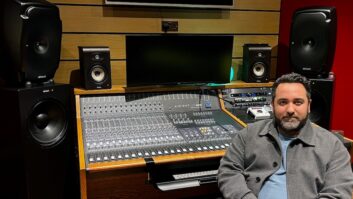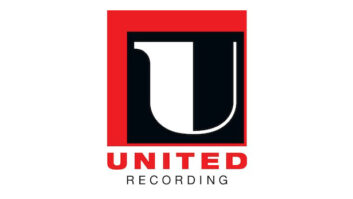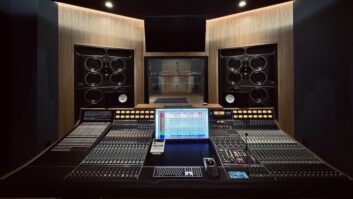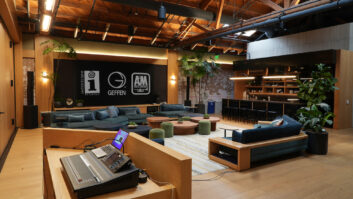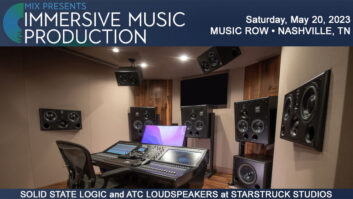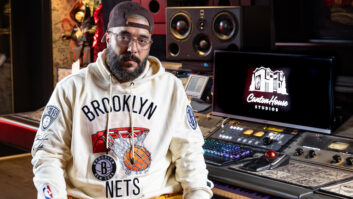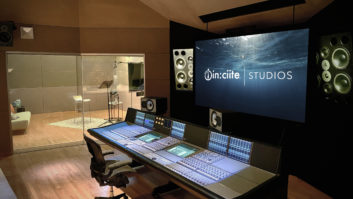New York City’s Conclave Studios boasts a unique focus and business model to nurture, produce and develop heavy metal, hard rock and progressive music artists. Founder Mitch Cox and engineer Jon Kita are truly passionate about working with new artists, providing them with the kind of knowledge normally gleaned via years in and out of the recording industry’s school of hard knocks.
Conclave Studios’ control room features a Neve Genesys analog console/DAW controller with Genelec 1037C main monitoring and overlooks a large and flexible tracking space, especially conducive to tracking metal-style drum kits. “We try to enable artists to progress to where they would normally be in five years by working with us for one year or less,” explains Cox. “We do that by taking a very long-term, intensive interest in our bands, helping them to develop as musicians, artists and as professionals, and directing them in operating their band as a business.”

Comparing the studio environment to a “manufacturing facility,” Cox strives to be honest with the artists Conclave Studios and its development side, The Conclave, takes under its wings. “We generally find the musicians we work with to be very pragmatic,” he offers. “None have illusions of making millions of dollars in metal. But with the right amount of guidance, discipline and planning, it’s our view that talented bands can and will make money to support a modest lifestyle. We work with these bands, and in effect, underwrite them. In The Conclave, the other branch of Conclave Studios, we form ongoing partnerships with our bands, guiding them through their careers. In fact, we’re launching three or four bands early this year, giving them all the tools, information, guidance and financing they need so they can move forward.”
This all works through creating discrete legal companies for each band; The Conclave owns half, and the band owns half. Because each company owns 100 percent of its intellectual properties, the musicians in the bands themselves own a portion of their copyrights, publishing, etc., in perpetuity. And most importantly, confirms Cox, “100 percent of the expenses associated with developing the company are paid for by The Conclave. To the extent that those expenses are greater than the company’s revenues, The Conclave picks up the tab. Over time, as the band starts to make money, we’re able to recoup our expenses. Once the band is profitable, we split profits with the band 50/50.” This allows bands to tour without worrying about per diem, gear, gas and merchandise needs while on the road, for just one example of benefits.
Cox’s laser-like focus on the needs of his protégés extends to the way Conclave Studios operates and is outfitted, too. After finding a former television commercial and jingle studio in the Starett-Lehigh Building—a historic, former freight terminal in West Chelsea now bustling with vibrant creative businesses, visitors and tenants—Cox and Kita sculpted the space into a premier hard rock production facility defined by carefully selected acoustic treatments and an analog-centric recording rig. “[The studio] had a sensible, professional configuration of rooms, which gave us a head start,” recalls Cox. “They were properly floated and the facility was very nice. We worked with Horacio Malvicino of Malvicino Design Group, an internationally-recognized acoustic design firm and developed sound treatments for our genres.”
While many indie, metal-centric studios or labels have their artists “hit the ground running,” so to speak—often relying, for example, on ubiquitous samples for kick, snare and tom sounds—Conclave Studios actively slows down the process and purposely emphasizes preproduction. From a socioeconomic perspective, most indie artists, and metal musicians in particular, don’t enter a recording studio in a financially advantageous position, which in turn limits luxuries such as hours just to get sounds, ultimately stifling stylistic needs and creative goals. “So we don’t just have bands come into the studio to record an album,” tells Cox. “[Pre-production is] our chance to learn and help progress their music, allowing them to become better musicians for their next pre-proor formal recording session. It’s a constant building process.”
Drum tracking is especially crucial in high-quality hard rock/metal production, thus Cox weighed the live room’s acoustic design and treatment carefully with Malvicino. “In our primary tracking room, we focused on having maximum diffusion,” he continues. “The most difficult instrument in our repertoire to capture is the heavy metal drum kit: double kicks, 8 to 12 cymbals, five or so toms and massive amounts of SPL that cover the entirety of the audible frequency spectrum. We created custom acoustic treatments—from resonator panels to diffusion panels, bass traps, to sound clouds in the ceiling—to allow us to capture the essence of that very complex instrument while avoiding some of the problems usually encountered in doing so in any enclosed space. We were also going to use the room for recording and re-amping guitars. To create complete sonic flexibility, our diffusion panels were placed on hinges, with the other side having resonator panels. With a few flips, we can record drums with maximum diffusion, then flip a couple of panels around and have, for example, a bluesy singer in there, making it sound more like an amphitheater.”
Equipment-wise, Conclave Studios is outfitted with “flavor” in mind, featuring a range of some of the best-known metal guitar amp head/speaker cabinet combos 6-, 7-, and 8-string studio guitars, two complete drum kits and range of cymbals. The studio is anchored by a 24/48-channel AMS Neve Genesys analog console featuring 1073 preamps and 1084 EQs with Encore2 automation and DAW control tied to a 48-channel Avid Pro Tools|HD rig with Genelec 1037C main monitors. Focusrite ISA Series, Midas and Vintech outboard preamps; dbx, Empirical Labs and Vintech compressors; and a healthy variety of Radial Engineering DIs further highlight Conclave Studios’ gear list.
“Even some of the most artistic technical metal can sound sterile because you’re playing many notes with staccato precision very quickly, potentially giving it a cold feel,” explains Cox in the choice of a largely 1073 front end. “[This preamp] brings out the harmonic character of those notes, adding to it. From that perspective, the 1073 was absolutely the way to go.”
The Genesys ideally fits the way Conclave Studios operates, too. “We wanted to be able to simultaneously monitor multiple channels in the studio very efficiently while tracking and during pre-productions,” reasons Cox. “When the artist is in the other room, jumping back and forth between [control and tracking], you want to be able to monitor on as many channels as possible—quickly throwing up a solo, for example. Our Neve, an inline console, allows us to set the preamp section of the board, then seamlessly switch between DAW and analog monitoring on the fly. It aids our artistic process.”
Conclave Studios
conclavestudios.com

